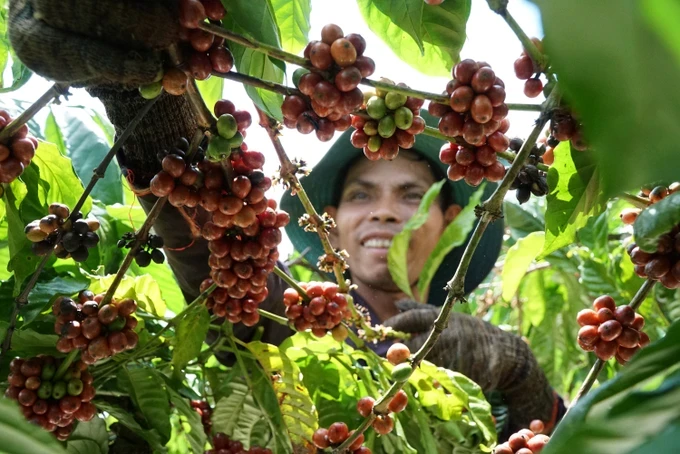Backward processing industries impede agricultural products’ competitiveness
In the agricultural value chain, farming and production represent the least profitable stages, contributing merely 12 percent-13 percent of the total added value.

That was indicated by former Minister of Agriculture and Rural Development, Cao Duc Phat.
According to him, over 80 percent of the remaining value is generated in the areas of processing, brand development, and sales. It is noteworthy that the segment yielding the highest profit does not align with Vietnam's core competencies.
Businesses primarily export raw products
Global coffee trade generates an estimated US$100 billion annually, yet coffee growers receive a mere 15 percent of this value, while the remaining 85 percent flows to processing, distribution, and branding operations primarily located in non-coffee-producing countries.
In Vietnam, a representative of the Vietnam Federation of Commerce and Industry (VCCI) informed that most of the exported agricultural products still have to be sold raw, the profits are not as expected. For coffee, if raw coffee beans are exported, the current price is only about $2,400 a ton, but if processed, it can be $3,600 a ton.
Vietnam is home to over 7,500 enterprises engaged in the processing of agricultural, forestry, and fishery products, concentrating on essential commodities. Annually, approximately 120 million tons of agricultural raw materials are processed. These statistics indicate a robust processing sector; however, the Department of Quality, Processing and Market Development under the Ministry of Agriculture and Rural Development notes that the country's agricultural processing technology remains limited and outdated, with around 95 percent of the establishments classified as small to medium-sized.
Furthermore, preliminary processed products constitute a significant portion of the output, accounting for about 70 percent to 80 percent, while the share of deeply processed products with higher added value remains relatively low.
Due to their small scale, enterprises find it difficult to meet food safety requirements and technical barriers to export. Coffee farmers often face significant challenges in the global market. One major issue is a lack of market information, leaving them vulnerable to price fluctuations. During bumper harvests, traders often exploit this lack of information by forcing down prices, resulting in low profits for farmers.
This limited income hinders their ability to reinvest in their farms, such as upgrading processing facilities and machinery, which are crucial for building a more integrated and profitable value chain. Furthermore, some farmers may resort to unethical practices, such as exaggerating the size of their growing areas, which can compromise food safety standards.
At the Forum 'Connecting production and consumption of coconut products"'organized by the Ministry of Agriculture and Rural Development in Ben Tre province in mid-December 2024, a surprising piece of information was that the coconut industry has the potential to become a billion-dollar export industry in 2024, but businesses and associations simultaneously sought help from responsible agencies.
According to Technical Director Nguyen Phong Phu of Vina T&T Company, on December 12, 2024, the company discovered that a shipment of 10 containers of fresh coconut exported to China has faked the company's growing area code and packaging facility. This issue needs to be thoroughly resolved to ensure the sustainable development of the coconut export industry.
In October 2023, two shipments of durians and chili peppers from Vietnam were destroyed upon arrival in Japan after tests revealed chemical residue levels exceeding permissible limits. The importer, Japan Apple LLC, incurred losses amounting to hundreds of millions of Vietnamese dong.
Director Nguyen Phong Phu stated that numerous organizations, after obtaining growing area codes, have violated regulations by reselling or leasing them, as well as falsifying information about product origins. In some cases, growing areas have failed to maintain production in compliance with registered standards, resulting in violations of plant quarantine and food safety regulations.
These issues have negatively impacted export quality and prompted importing countries, particularly China, to tighten controls or suspend imports from Vietnam. Consequently, this has caused significant harm to farmers and legitimate businesses.
In recent years, Vietnamese coffee has been a large export industry, present in more than 80 markets, bringing in billions of dollars to the country each year, but in reality, the export value remains low due to the large proportion of raw coffee exports. The Ministry of Agriculture and Rural Development said that the country currently grows about 710,000 hectares of coffee, mostly in the Central Highlands.
In the 2023-2024 crop year, Vietnam's coffee exports have reached 1.45 million tons, with an export turnover of more than $5.4 billion.
Vice President Thai Nhu Hiep of the Vietnam Coffee and Cocoa Association said that the export rate of deeply processed coffee is very low, businesses mainly export raw materials to foreign partners.
Lack of preservation technologies
Vietnamese agricultural exports face significant challenges, including inadequate preservation, limited processing capabilities, and outdated infrastructure. These shortcomings result in high post-harvest losses, estimated at 25-30 percent of total output, significantly impacting the competitiveness of Vietnamese agricultural products in the global market. Moreover, order cancellations due to quality issues have damaged the reputation of Vietnamese businesses and the country's agricultural brand.
Hanoi is home to thousands of agricultural processing facilities, but 98 percent are small or medium-sized and rely primarily on manual production methods. Modern production lines and advanced storage systems remain scarce, highlighting the mismatch between the city's agricultural processing capabilities and the potential of its agricultural sector.
Statistics from the Ministry of Agriculture and Rural Development indicate that Vietnam's annual harvest of fruits and vegetables reaches approximately 31 million tons. Nevertheless, only around 4.5 million tons are processed, representing about 12 percent to 17 percent of the total national output of these products.








